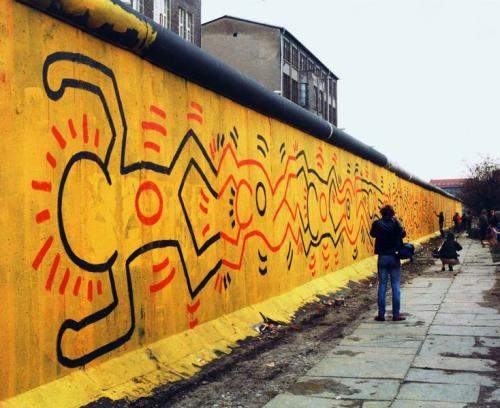When Keith Haring was painting on the Berlin Wall.
In Berlin, the Mauermuseum, or the museum documenting the history of the Berlin Wall, has been in operation since 1962. It is also known internationally as Checkpoint Charlie Museum, named after the very famous checkpoint that controlled the flow between East and West Berlin. And today it is one of the most visited museums in Berlin, partly because it is located in one of the areas of the city, the area on which the checkpoint once stood, that hold the most fascination for visitors.
The Berlin Wall, as anyone who has seen it in photos or videos (or even live, should they have visited the German capital before its fall on November 9, 1989) knows, was covered with artwork and graffiti. Or rather: only the facade of the west side was covered. In East Berlin, guards did not allow people to get so close to the wall that they could paint on it. And even today, the pieces of the wall that have been preserved are still covered with paintings, many of them moreover recently restored in order to preserve them from the elements.
In 1986 it happened that the Mauermuseum decided to call upon one of the greatest artists and writers of the day to create a graffiti on a portion of the wall about 300 meters long. The artist was the great Keith Haring (1958 - 1990), who gladly accepted the proposal and went to Berlin that very year, 1986. Keith Haring, at that time, was already a famous artist, and his arrival in Berlin was also a bit of a media event: so the works were extensively documented. And the work lasted barely a day. The artist’s assistants covered the portion of the wall to be painted with a yellow dye, and the next day Keith Haring completed the work, taking just six hours.
The artist was aware of what that wall represented: an obstacle to freedom. The Berlin Wall, as we know, prevented free movement between East and West Berlin: in fact, citizens of the East were forbidden to cross the border. Those in the West, on the other hand, could cross the border upon payment of a visa and limitations on visiting hours. And so, Keith Haring’s intent could only be one: to destroy the wall by painting it, as he had to declare.
His work also represented a practical challenge. For to work in the best possible way, Keith Haring also had to cross the border. The West Berlin guards, while he was working, warned him via megaphones about the risks if he tried to cross the border: he could be arrested. The East guards, for their part, wanted to verify that Keith Haring’s painting did not outrage the GDR: only when they understood the work’s message was the artist free to continue his work unhindered.

Keith Haring’s large mural in fact aimed to convey a message of unity and concord between the peoples of East and West Germany. On the large yellow base, Keith Haring painted a long chain of human figures joined through the joining of hands and feet. These figures were made with red and black, so that the mural, when finished, had only three colors, those of the German flag: yellow, red and black. And the figures are those round and sinuous ones, consisting only of a closed line, typical of Keith Haring’s style. Just as typical are the small lines that highlight the movements, gestures, and expressions of the characters. A message, then, devoid of any kind of provocation: only the hope that one day we might see the two peoples reunited. So much so that the message was not aimed at either area of Berlin in particular, according to Keith Haring’s intent: the message was meant to be universal. And to see the two peoples reunited, the artist and the world had to wait only three years. Almost exactly, because Keith Haring’s painting is dated October 23, 1986.
It was, however, a work that caused debate. Some commentators necessarily wanted to see political messages in it, but these were denied by the artist, for the reasons we mentioned above: it is a universal message. But most of those who were fortunate enough to see the painting, appreciated and praised it. They were fortunate enough to see it, because the day after it was painted, there were some who covered large portions of the work with layers of gray paint: likely a sign of protest and contempt for an artist who, let us remember, was from the United States. And even though the Cold War was nearing its conclusion and détente between the two blocs had been underway for some years, distrust was still a widespread feeling.
Haring’s mural, which had thus managed to convince even the GDR authorities, could not survive the graffiti writers who covered it. For even the pieces that were saved from the action conducted the day after the work was finished were covered over in the months that followed, and by the time the wall fell, Keith Haring’s painting had become almost unreadable. The artist, however, was aware of the end that would befall his painting. It was he himself who said that his art was meant to be temporary and not permanent. He, too, after all, had repeatedly found himself covering works by other artists. Such is the fate of graffiti art. But the images remain to document the importance of a message that, unlike the work, will last forever.
Warning: the translation into English of the original Italian article was created using automatic tools. We undertake to review all articles, but we do not guarantee the total absence of inaccuracies in the translation due to the program. You can find the original by clicking on the ITA button. If you find any mistake,please contact us.



























